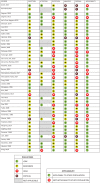The incidence and prevalence of delirium across palliative care settings: A systematic review
- PMID: 31184538
- PMCID: PMC6691600
- DOI: 10.1177/0269216319854944
The incidence and prevalence of delirium across palliative care settings: A systematic review
Abstract
Background: Delirium is a common and distressing neurocognitive condition that frequently affects patients in palliative care settings and is often underdiagnosed.
Aim: Expanding on a 2013 review, this systematic review examines the incidence and prevalence of delirium across all palliative care settings.
Design: This systematic review and meta-analyses were prospectively registered with PROSPERO and included a risk of bias assessment.
Data sources: Five electronic databases were examined for primary research studies published between 1980 and 2018. Studies on adult, non-intensive care and non-postoperative populations, either receiving or eligible to receive palliative care, underwent dual reviewer screening and data extraction. Studies using standardized delirium diagnostic criteria or valid assessment tools were included.
Results: Following initial screening of 2596 records, and full-text screening of 153 papers, 42 studies were included. Patient populations diagnosed with predominantly cancer (n = 34) and mixed diagnoses (n = 8) were represented. Delirium point prevalence estimates were 4%-12% in the community, 9%-57% across hospital palliative care consultative services, and 6%-74% in inpatient palliative care units. The prevalence of delirium prior to death across all palliative care settings (n = 8) was 42%-88%. Pooled point prevalence on admission to inpatient palliative care units was 35% (confidence interval = 0.29-0.40, n = 14). Only one study had an overall low risk of bias. Varying delirium screening and diagnostic practices were used.
Conclusion: Delirium is prevalent across all palliative care settings, with one-third of patients delirious at the time of admission to inpatient palliative care. Study heterogeneity limits meta-analyses and highlights the future need for rigorous studies.
Keywords: Delirium; incidence; palliative care; prevalence; systematic review.
Conflict of interest statement
Figures





Comment in
-
Delirium in the palliative care setting: "Sorting" out the confusion.Palliat Med. 2019 Sep;33(8):863-864. doi: 10.1177/0269216319861896. Palliat Med. 2019. PMID: 31395002 No abstract available.
References
-
- Brajtman S. The impact on the family of terminal restlessness and its management. Palliat Med 2003; 17(5): 454–460. - PubMed
-
- Namba M, Morita T, Imura C, et al. Terminal delirium: families’ experience. Palliat Med 2007; 21(7): 587–594. - PubMed
-
- Witlox J, Eurelings LS, de Jonghe JF, et al. Delirium in elderly patients and the risk of postdischarge mortality, institutionalization, and dementia: a meta-analysis. JAMA 2010; 304(4): 443–451. - PubMed
Publication types
MeSH terms
LinkOut - more resources
Full Text Sources
Medical

